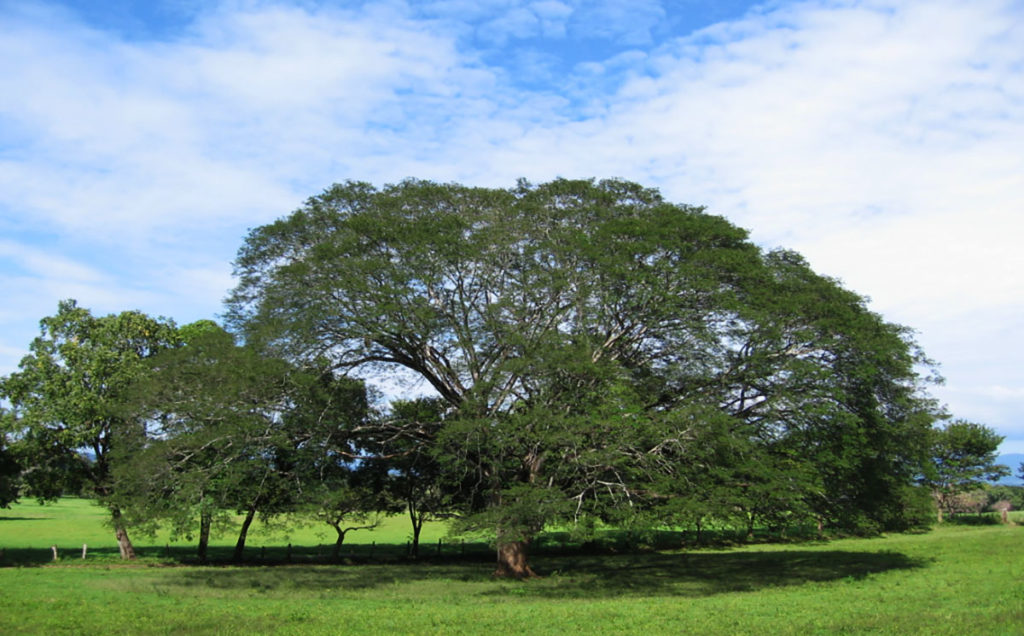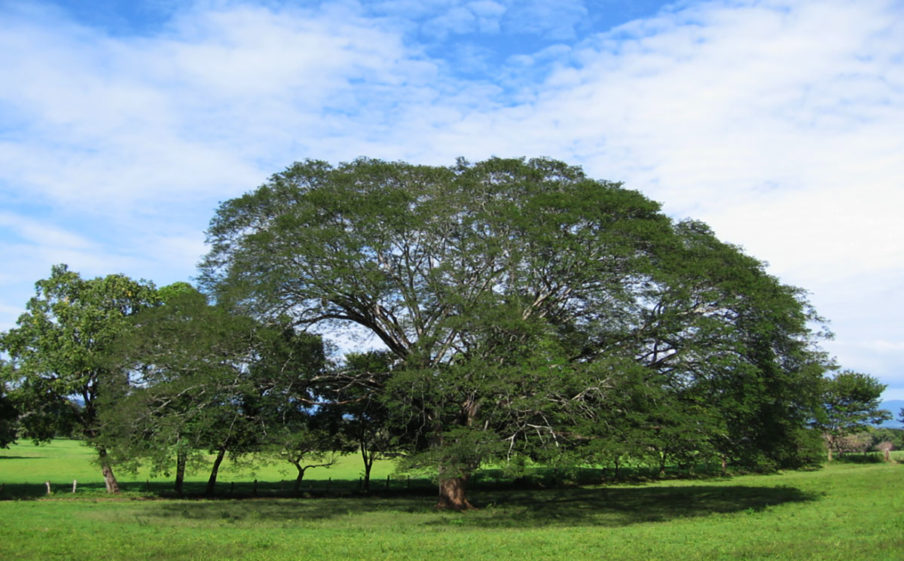
The Guanacaste tree is the National Tree of Costa Rica. It is known for its expansive, hemispherical canopies of feather like leaves. It provides fruit for sustenance, wood for shelter, and some species even provide a ready source of water.
Their presence in any given area can be a determining factor for a Costa Ricans community’s prosperity. Yet still, many people take them for granted. Since trees are such an indelible part of most landscapes, we don’t really think much about them until they’re gone.
Today, we’ll be taking a closer look at the Guanacaste tree and its mark on Costa Rica.
The Guanacaste Tree of Costa Rica
The Enterolobium Cyclocarpum goes by many common names, including the elephant ear tree, monkey ear tree, caro caro tree, and of course, the Guanacaste tree.
The tree can grow over 160 feet, with its trunks growing as thick as 7 feet in diameter. It is known to live for over 70 years. Its flowers bloom between November and March, and it bears fruit between January and May.
The tree’s hemispherical crown, its most impressive feature, can grow wider than the actual height of the tree, providing shade over a vast area. Some people would actually compare the shape of the Guanacaste Tree to a portobello mushroom, thanks to its distinctive profile.
The Guanacaste tree itself is very abundant in Costa Rica despite the very hot and dry climate. In fact, it’s so numerous that a province in Costa Rica, Guanacaste in the northwest portion of the country, is named after the tree.
Its other names, the Elephant Ear Tree, or the Monkey Ear Tree, comes from the distinct shape of the tree’s seed pods, which do resemble the ears of the animals the tree is named for.
The name Guanacaste itself is thought to be Nahuatl, the Aztec language, in origin, which basically means ear, referencing the seed pods. Aside from its sought after shade, the tree is also used by the locals as a source of good-quality wood that is easy to work with and highly resistant to water, termites, and fungus growths.
The tree’s tolerance to extreme climate, as well as its ability to grow in poor soil conditions and survive severe drought has made it a popular tree to cultivate for wood.
The Guanacaste Tree also grows remarkably fast, reaching to almost 40 or so feet during its first year, making it very sustainable for wood harvesting. Unfortunately, however, many people have expressed concern over its fast growth, fearing it could become an invasive species under the right conditions.
Cultural Significance of the Guanacaste Tree
The Guanacaste Tree has had an indelible mark on Costa Rica’s culture. Its wide crown has provided shade from the hot Costa Rican sun to many travelers, and its leaves and fruits provide sustenance to the cattle that feed the common folk.
It has had such an effect on the country’s culture and people’s everyday lives that on August 31, 1959, the Guanacaste tree was designated as Costa Rica’s National Tree.
The tree itself was chosen due to its beauty and distinctly impressive crown, but also due to the shade it has provided over the country’s landscape and people for centuries.
The shade has become symbolic of the protection the people have received from the government of Costa Rica. Aside from this, the tree has become a symbol of collective equilibrium, strength in faith, the strength of nature and the process of sacred creation.
The speed in which it grows and spreads its seeds has been symbolic of growth, and its strong roots are symbolic of the strength of life. The Guanacaste Tree’s wide canopy also represents the Costa Rican people’s strong spiritual faith, one that spreads out far beyond the physical body of each individual.
Uses for the Guanacaste Tree
Aside from providing shade for many weary travelers, the Guanacaste Tree has many uses, including food, wood, cattle feed, and even medicinal purposes.
The tree certainly has something to offer everybody, so it’s not surprising that the tree is so ubiquitous, not only across Costa Rica’s landscape, but also within the population’s lives. Here are some of the ways Costa Rica’s National Tree is being utilized.
Wood
The Guanacaste tree produces a type of hardwood that is highly resistant to both humidity and termites, making it a good wood to use for furniture, doors, and window frames, as many Costa Ricans do. The wood is also used by the locals for building sea faring canoes. Despite it being classified as a hardwood, the Guanacaste is very easy to work with, thanks to its lightweight nature.
The wood itself also exhibits beautiful colorations, with swirling patterns of dark red hues and browns. It is because of these beautiful patterns that many Costa Ricans prefer to use it on furniture and other woodworking projects. In fact, it’s a popular wood to use in building Costa Rica’s iconic oxcarts. The wood is also resistant to decay even when in constant contact with water.
Food
The Guanacaste Tree produces seeds that can be eaten and is found to be a good protein source. The seeds are normally boiled when still green and can be eaten that way.
Of course, since the seeds do develop quickly, there’s only a small window when the seeds are edible. The seeds can also be ground up and roasted, or the whole seeds can be grilled after being seasoned with molasses. The seeds do become difficult to consume once they dry up, but many locals use them to create distinctive jewelry.
The seeds themselves are also a great food source for cattle, especially so in dry areas where grass pasture can be difficult to come by. The leaves can also be a good source of food for cattle. Thanks to haw quickly the Guanacaste Tree can grow, many ranchers plant the tree in their property, providing shade for the animals as well as a ready source of food.
Alternative Folk Medicine
The Guanacaste Tree isn’t just used for food, shelter and a source of wood, it also has properties that can help people heal. The sap of the tree, aside from being used as a natural adhesive, is known to help cure the flu and even some lung infections.
The fruit of the tree is also known to help alleviate diarrhea. If you have skin problems that worsen when you use commercial soap, the sap from the Guanacaste Tree is a good substitute for soap, and can even be chewed as a gum.

